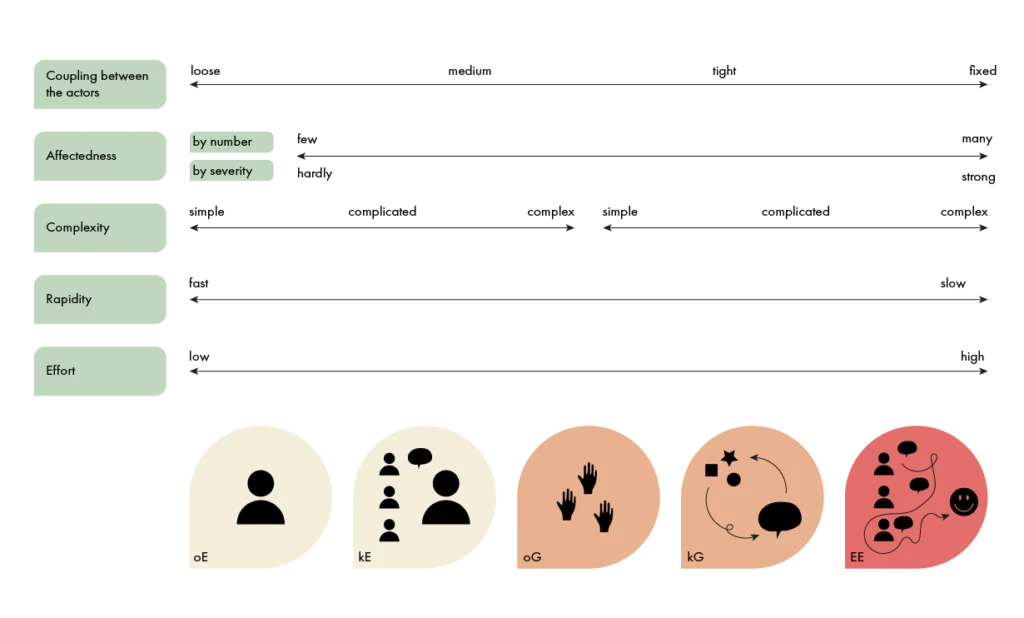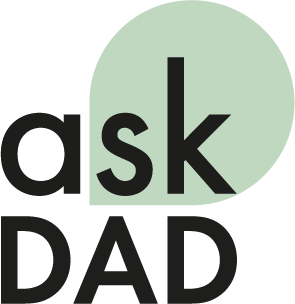Module 1 is about how something should be decided.
- Is the decision made by an individual or a group?
- Should the person (or role) ask others first?
- Are we striving for consensusS or consensusT?
And the answers to the questions naturally depend very much on the content. The following examples show that there are fundamental differences:
- Am I taking a break now?
- Who decides which template I use for my presentation?
- Where are we having lunch today?
- Are we closing the plant in XX?
- Are we investing all our budget in Project Z?
- Are we closing the company down?
Methods
The methods are derived from the dimensions described below:

To summarize, it can be said that the methods can process more and more input, i.e. more involvement, more complexity, etc. and are therefore themselves becoming more and more complex:
- Operative individual decision (oE): One person alone and only that person decides
- Consultative individual decision (cI): One person decides, but consults others beforehand
- Operative group decision (oG): A group makes the decision based on fixed alternatives
- Consultative group decision (kG): A group makes the decision by developing alternatives before evaluating them individually
- Unified decision (EE): Everyone works together until everyone agrees
It is important to clarify that the individual methods are not clearly distinguishable. Ultimately, it doesn’t matter whether what you end up doing falls under the operational group decision or the consultative group decision. It is only important that you are aware of the spectrum from a completely autonomous individual decision to the jointly developed unified decision and that you use it!
In order to make good use of this spectrum, it is important to understand the principle of consensus.
We have modeled the first three dimensions in Module 1 with a question game. This allows you to playfully find out how the decision should best be made when you have to make a decision.
Dimensions
Complexity
We assume that decisions improve with the quality of information. In situations of uncertainty, different perspectives are helpful.
So if the topic is complex because the alternatives are powerful, it is advisable to involve several people in the decision – this is the famous group or swarm intelligence!
So we are at least at the level of a consultative individual decision. And if the alternatives are so powerful that you cannot use classical decision theory to work out which is the best (see also here), but instead need people’s intuition, then a group decision is recommended.
Concern
If people are affected by our decisions, they should be involved. Affectedness describes the impact of the decision on others. This means that they themselves are (in)directly affected, depending on how the decision is made. In risk theory and the project business, there is often the formula scope x severity x probability of occurrence, which also forms the basis of the “affectedness” dimension in DAD.
Coupling
In cases where people are not personally affected, but – especially in the work context – “only” their actions, their own work is influenced, then we speak of “coupling”. Here are a few examples from the world of work and at a societal level to differentiate between being affected and being coupled:
- If the management decides that expenses are to be submitted differently in future, every employee will still get their money back (i.e. not affected), but must do it differently (linkage).
- If the government decides that certain costs will no longer be deductible in future, then the companies will be affected, but in extreme cases they will not be linked at all because they absolutely need the cost-causing resources and therefore their work will not change.
- If the state decides that every employee should be paid an energy price allowance via the payroll, then the employees are positively affected in the sense of being “affected” and the payroll accountants such as tax consultants and HR departments of the companies are coupled because they now have to do something different or additional.
Impact is therefore about the (positive or negative) effects on someone (or an organization). Coupling is about changes in activities.
Speed and effort
Finally, it should be noted that individual decisions are generally quicker and less time-consuming than group decisions. If you need a decision here and now, there is no other option than to decide for yourself. If you have a burst water pipe, there is usually no time to convene an owners’ meeting, but you decide to turn off all the supply pipes yourself, even if this could cause other damage that you might have seen if you had consulted others. And it is also clear that the more people are involved, the greater the expense. A profitability analysis suggests that the increasing (time and cost) effort must also be justified. As a rule, however, the effort required for the decision is marginal compared to the effort required for the subsequent implementation of a strategically important decision. This is why it is not considered as a separate dimension in our Module 1.
